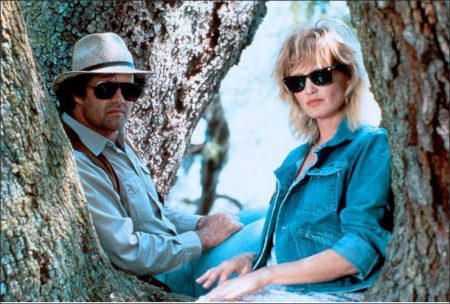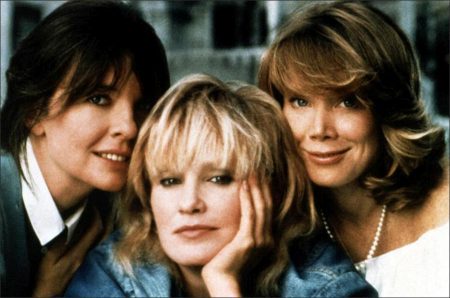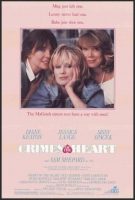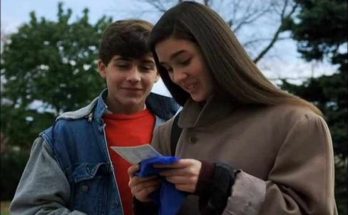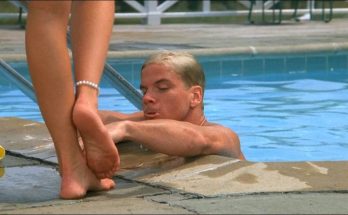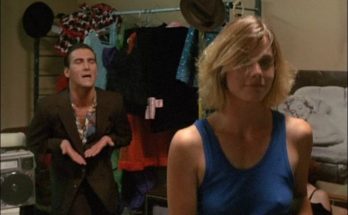Taglines: The MaGrath sisters sure have a way with men!
Crimes of the Heart focuses on the Magrath sisters—Lenny, Meg, and Babe—who reunite at the family home in Hazlehurst, Mississippi, after Babe shoots her abusive husband. The three were raised by Old Granddaddy after their mother hanged herself and the family cat and have been eccentric ever since.
Lenny is a wallflower who bemoans her shriveled ovary. Egocentric Meg is a singer whose Hollywood career ended abruptly when she suffered a nervous breakdown. Unruly and impulsive Babe shocks her sisters with stories about her affair with a teenage African American boy. Past resentments bubble to the surface as the women are forced to deal with assorted relatives and previous relationships while coping with the latest incident that has disrupted their dysfunctional lives.
Crimes of the Heart is a 1986 American black comedy, southern gothic film directed by Bruce Beresford. The screenplay by Beth Henley is adapted from her Pulitzer Prize-winning play of the same name. The film tells the story of the three MaGrath sisters, Babe, Lenny, and Meg, who reunite in their family home in Mississippi to regroup and settle their past. Each sister is forced to face the consequences of the “crimes of the heart” she has committed.
Review for Crimes of the Heart
As written by Beth Henley from her Pulitzer Prize-winning play, “Crimes of the Heart” is a well-intentioned effort, but also a deeply misguided one — Henley’s humor, while suited to the stage, disintegrates in a more literal-minded medium. The lesson? Never hire a playwright to do a screen writer’s job, especially when the play is her own.
“Crimes of the Heart” concerns three sisters who reunite in their old Mississippi home when one of them gets in hot water. Babe MaGrath (Sissy Spacek) has shot her bully of a husband, which sends her spinster sister Lenny (Diane Keaton) into a dither. Meg (Jessica Lange), a failed singer and actress, buses in from L.A. to take care of both of them, but also to see her old flame Doc (a fine Sam Shepard), whom she abandoned long ago, and who has since married someone else.
Director Bruce Beresford and the spectacular cinematographer Dante Spinotti have lent “Crimes of the Heart” a style that is always appropriate, often ingeniously so. Spinotti’s light re-creates the Mississippi heat without ever becoming bland or bleached out, and Beresford frequently keeps you at a daring distance, using production designer Ken Adam’s architecture as a kind of proscenium arch.
And though the action takes place mostly in the MaGraths’ rickety old mansion, the movie never seems cramped or claustrophobic — Beresford’s fluid angles and gliding camera make the story cinematic.
But Henley’s attempts to open up her own play are less successful. Story elements (such as the shooting of the husband) that might be powerful when told in a stage monologue become mundane when you see them before your eyes. And while Henley has broadened the geographic scope of the play by bringing you “offstage” (to the jailhouse, the lake, the hospital), her storytelling is still wedded to the theater — the pivotal events are mostly recounted in flashback. The “present” of the movie is all dialogue, virtually eventless.
In various ways, “Crimes of the Heart” continually puts you at a remove from reality, all the while insisting that it is, at least in some sense, realistic. On film, monologues are risky business — you have to prepare for them in some way, and you can’t afford too many. Henley’s style, though, is monologue driven.
The content of those monologues only makes matters worse. Henley’s corn pone quirkiness, her blend of southern Gothic (Lenny’s “underdeveloped ovary”) and odd bits of Americana (a box of Fannie Farmer “Assorted Creams”) is too stylized for film (unless a tone of, say, surrealism is sustained throughout). Just as there’s a difference between the ways we receive spoken dialogue and dialogue on the page, there’s a gulf between how people talk on stage and on screen, something Henley refuses to acknowledge. The result is that her characters seem stilted and artificial.
When you cast, as the sisters, three of the biggest actresses in Hollywood, you take one more giant step away from reality, and it doesn’t help that Beresford rarely molds them into an ensemble. As Spacek, Lange and Keaton clamor for attention, “Crimes of the Heart” becomes less a movie than a three-ring circus, and ringmaster Beresford does little to direct your gaze.
The biggest loser is Keaton, who gives her most Keatonish performance in years — it’s exactly the kind of thing that, in movies like “The Little Drummer Girl” and “Mrs. Soffel,” she was getting away from. Struggling to set herself apart from the others, she becomes a parody of herself, all nervous gestures, daffy glances and Annie Hall tics. To a lesser extent, Lange, whose Tina Turner mini-dresses make her look monstrous amid her slightly built costars, is mannered and self-conscious — her Meg is merely adequate, with nothing near the force of her best work.
The most remarkable thing about “Crimes of the Heart” is the way Spacek blows both of these powerhouses off the screen. Of the three, Spacek’s metier is closest to Henley’s, so you’d expect her to seem more comfortable; but still, you get the feeling that she’d make even “The Bride of Frankenstein” seem natural, lived in. In “Crimes of the Heart” and, for that matter, in her entire career, Spacek never strikes a false note.
And in that way, she succeeds exactly where “Crimes of the Heart” fails — when she takes center stage, you’re finally freed from the movie’s perpetual limbo. In all likelihood, “Crimes of the Heart,” even with its Pulitzer Prize, couldn’t have been made without its big-name cast, and for good reason. It should have occurred to someone that a movie marquee is a lousy drawing board.
Crimes of the Heart (1986)
Directed by: Bruce Beresford
Starring: Diane Keaton, Jessica Lange, Sissy Spacek, Sam Shepard, Tess Harper, David Carpenter, Beeson Carroll, Jean Willard, Annie McKnight, Eleanor Eagle
Screenplay by: Beth Henley
Production Design by: Ken Adam
Cinematography by: Dante Spinotti
Film Editing by: Anne Goursaud
Costume Design by: Albert Wolsky
Set Decoration by: Garrett Lewis
Art Direction by: Ferdinando Giovannoni
Music by: Georges Delerue
Distributed by: De Laurentiis Entertainment Group
Release Date: December 12, 1986
Views: 205
